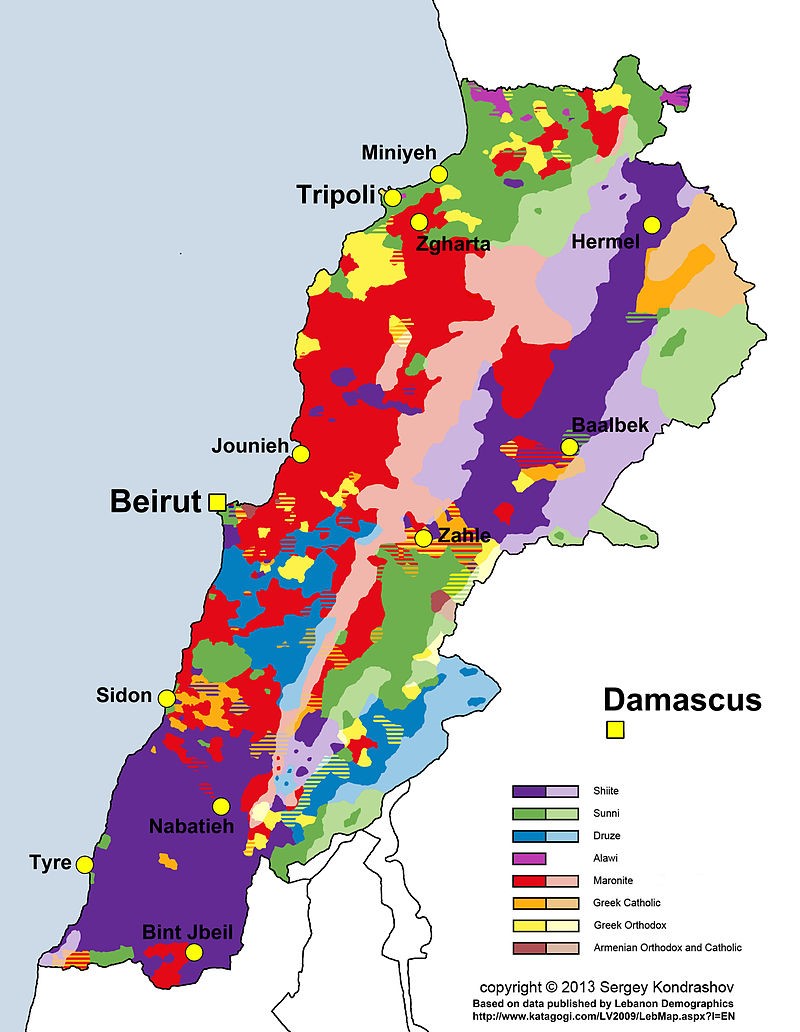Abstract
The question of federalism in Lebanon dates back to the years prior to the civil war in 1975. In the Taif Agreement of 1989 federalism was rejected in favor of administrative decentralization. Today, the topic of federalism is revived and it is seen by some groups as a solution to all the problems of the country. This article seeks to understand the problems of a possible federal solution for the Lebanese republic.
Introduction
The question of federalism in Lebanon emerged just prior to the Lebanese civil war in 1975. The Lebanese right wing parties aligned in the Lebanese Front, involving many Christian politicians, championed the cause of federalism. The Document of National Reconciliation of 1989, known as the Taif Agreement (signed in the Saudi city of Taif), under regional and international auspices, brought an end to the Lebanese civil war and introduced administrative decentralization instead of federalism.
The country today is facing its worst economic crisis, with bank depositors almost on the verge of losing their life savings, the country defaulting on its debt since March 2020, shortage of dollars in an economy that fully relies on imports, an absence of an economic rescue plan, and above all, the stagnation in forming a new government. Hence, some groups are calling for a federal option in Lebanon as a solution for political stalemates and the country’s economic crisis. Therefore, the question that I intend to answer in this article: Is federalism viable in a small-highly diverse country like Lebanon? For this purpose, I start by introducing the characteristics of federalism according to the literature, I then move on to discuss the presence of a failed-federal experiment in 19th century Lebanon that lasted for almost two decades. Afterwards, I discuss the problems of a federal option in today’s Lebanon.
On the Characteristics of Federalism
A very important characteristic in many federal systems is that each entity has its own written constitution which the central authorities is obliged to respect. The constitution of the entity gives territorial autonomy for its institutions to govern accordingly, so it is important to establish well-defined borders between federal entities due to the changing nature of laws between them. Another important characteristic is that of bicameralism, as in the United States where there is equal representation of states in the Senate (upper house), and the House of Representatives (lower house) where number of representatives from each state depend on its portion of the overall population.
At the bureaucratic and institutional level, federalism requires that each entity manages its own affairs by itself. Consequently, we find state-level ministries to look after the affair of the population living in each entity. This means that each entity has its own laws, judiciary, tax system, educational policy, and above all, security apparatus (Lijphart, 1979). This means that each federal entity functions in a similar manner like a state (Lijphart, 1985). The interaction between the central authorities and the entity government differs from one case to another, as federalism can be highly decentralized, giving more powers to federal entities as in Belgium and Switzerland, or balanced as in the American case.
It is important to note that the most successful cases of federalism have been applied in states that are territorially huge, compared to the size of Lebanon. Also, these states either apply territorial autonomy for administrative purposes because of their huge territory, like in the case of the USA, or to allow ethnic communities to govern themselves (McGarry and O’Leary, 2005), especially when ethnic boundaries are clear-cut, as in Quebec(Canada), Belgium, and Switzerland. However, there are cases where there is no clear-cut boundaries between ethnic communities, and the territory of the state itself is extremely small, as in the case of Lebanon. Thus, it becomes a myth, or an illusion, to implement a federal option for the political – and now the economic – problems of the Lebanese case.
The Historical Antecedence of “Federal Petite Liban”
In 1840 after a series of massacres in Mount Lebanon between Maronite Christians and Druze, the great powers (UK, Austria, France, Prussia and Russia) intervened and put an end to the crisis. A political system known as the Kaim-makamiyah (Dual Subgovernorship of Mount Lebanon) was established. The system was based on the division of the mountain into two parts: the northern part to be ruled by a Maronite Christian prince, and a southern part to be ruled by a Druze prince, with the famous Beirut-Damascus highway dividing the two entities (Churchill, 1862).
This system created two autonomous regions in the mountain, independent from one another, extremely similar to a modern federal system. Each had its own laws, rules, taxation and socio-political interaction between the prince and the subjects. The problem emerged because territorial autonomy was not enough, the Maronite Church (an emerging political power at that time) demanded that Christians living in the southern part answer to the Christian prince under the threat of ex-communication, rather than the Druze one. Consequently, the challenge to the rule of a Druze prince and the disregard to territorial autonomy led to violence in 1860 and the failure of this quasi-federal experience in the mountain (Aboultaif, 2019).
The Democratic Crisis of Federal Lebanon
In a federal system with mutli-ethnic groups that have gone through the process of “ethnurgy,” (Hanf, 1995), that is the politicization of ethnic identities, a federal option perfectly suits a state whose internal-ethnic boundaries can be neatly drawn. That is to say that entities in a federal society are highly likely to be homogenous, as in Belgium and Switzerland. But in Lebanon, most areas – if not all – are basically mixed, as shown in the map below. Hence, the first problem that we will encounter in a federal option is how to draw federal boundaires. The antecedent in the 19th century tells us that the Lebanese are not capable of understanding the limits of non-autonomous – that is – cultural sovereignty. Hence, cultural and territorial autonomy will definitely come into conflict because Lebanon does not have homogenous territorial boundaries. This is what led Theodor Hanf to refer to the Lebanese civil war as a time of “Coexistence in wartime Lebanon” (Hanf, 1993).

As Lebanon has been a power-sharing political landscape (formally since 1860), it has heavily depended on the corporate distribution of seats for political representation. Taking into consideration the demographic heterogeneity of regions, one has to ask what would be the religious affiliation of the governor of the Shouf area, for instance, which in its very right can be a federal entity. The same question arises for the governor of Beirut and Bikaa’. Another question is related to the need to discover several “magic formulas” to implement in each federal entity with respect to communal representation in the entity-level parliament. Lebanon has never had a proper representative formula based on demography, as in the case of the post-independence 6 to 4 in favor of Christian even though Muslims were almost half of the population, and the parity technique established in the Taif republic (though Christians today are less than half of the population).
Constitution and Culture
Every federal entity requires a written constitution of its own. The heterogeneous nature of entities in Lebanon means that cultural affiliation and the nature of laws will be highly contested. Take for instance a prospective federal entity in the south of Lebanon, highly dominated by the Shiite population, many of whom are Hezbollah supporters. While the majority of southerners are Shiite, there is a decent number of Christian and Druze people who inhabit the region. With Hezbollah, it is highly likely that the constitution of the federal entity of the south will be influenced by Islamic Sharia, particularly Khomeini’s doctrine of Velayat el Faqih. There are many cases today of sacking alcohol shops in the south, but then one can imagine what would be the status of secular, non-religious people in such a federal entity. Another prospective problem relates to the status of Christian and Druze communities in a region that is highly likely to have a constitution closely affiliated to that of Iran.
Security Sector
A final point relates to policing communities in each federal entity. Currently, with the presence of Hezbollah as an armed military group, it is likely that in return for accepting federalism, Hezbollah will legitimize its status constitutionally, through a clause that allows it to function independently from the federal authorities. As a result, other entities will follow suit in creating police forces on paper but with capabilities of that of an army in reality. The result would be the militarization of societies in federal Lebanon, again because each entity may have a regional patron, as in the case of Iran and Hezbollah.
It is important to take into consideration the composition of the security forces in each entity. Again, according to what formula will the ethnic composition be distributed in the police force? To which community will the police chief belong, what are his powers, who has the command over the police, the governor or the entity-level parliament? Similarly, we have to ask about the composition of the national guards and who has the right to deploy them. It took Lebanon more than three decades, a mini-civil war in 1958 and a major one in 1975 to reform its army. It will not be an easy process to agree on this security issue.
Conclusion
Lebanon needs political reform that begins with a new electoral law, allowing newcomers to the political landscape to introduce new ideas and possibly achieve change. The current politicians are the remnants of the civil war that ended in 1990. The Taif political system is the best form of power-sharing Lebanon can implement to achieve stability. Hence, it is futile to discuss federalism when Taif talks about decentralization. The problem lies in the fact that Lebanese discuss catchy political phrases without knowing the dangers, or threats, of implementing them. It is safe to say that federalism is a myth and an illusion in Lebanon. The federal requirements to be applied in Lebanon does not guarantee stability and prosperity. Perhaps we need to fine-tune the Taif Agreement instead of overhauling the political system.
Aboultaif, E. W. 2021. ‘The Federal Question in Lebanon: Myths and Illusions’, 50 Shades of Federalism.
References
Aboultaif, Eduardo Wassim, 2019. Power Sharing in Lebanon: Consociationalism since 1820. London, Routledge, 2019
Churchill, Charles Henry Spencer. [1869], 2007. The Druze and the Maronite Under the Turkish Rule from 1840 to 1860. New York: Cornell University.
Hanf, Theodor. 1993. Coexistence in Wartime Lebanon: Decline of a State and Rise of a Nation. Translated by John Richardson. London: I.B. Tauris and the Centre for Lebanese Studies.
Lijphart, Arend. 1979. “Consociation and Federation: Conceptual and Empirical Links.” Canadian Journal of Political Science 12 (3): 499–516.
Lijphart, Arend. 1985. “Non-Majoritarian Democracy: A Comparison of Federal and Consociational Theories.” Publius: The Journal of Federalism 15 (2): 3–15.
McGarry, John and O’Leary, Brendan. 2005, “Federation as a Method of Ethnic Conflict Regulation” in S.J.R. Noel ed., From Power-sharing to Democracy: Post-conflict Institutions in Ethnically Divided Societies. (Montreal and Kingston; McGill-Queen’s University Press), 263-96.
Kondrashov, Sergey. 2013. http://www.katagogi.com/LV2009/LebMap.aspx?I=EN
Further Reading
Harris, William. 2012. Lebanon: A History 600–2011. Oxford: Oxford University Press.
Khalaf, Samir. 1994. “Culture, Collective Memory, and the Restoration of Civility.” In Peace for Lebanon?, by Deirdre Collings, 273–285. Colorado: Lynne Rienner.
Lijphart, Arend. 1985. “Non-Majoritarian Democracy: A Comparison of Federal and Consociational Theories.” Publius: The Journal of Federalism 15 (2): 3–15.

